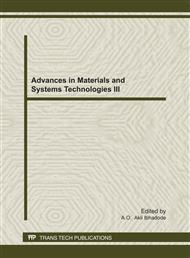p.75
p.83
p.89
p.97
p.107
p.117
p.125
p.133
p.143
Rural Electrification in Oyo State of Nigeria: Assessement of Existing 33kv Feeder Network Capacity
Abstract:
The aim of this study was to assess the capacity of the existing primary feeder network (33 kV) and to determine ways of reinforcing it in view of prospective full scale electrification and power demand of the rural areas of Oyo State. This work was done by using data of maximum power demand allocations to fully electrified areas of the State to compute expected range of power demand per capita, and applying normal mode simulations and solutions using iterative approximation and direct matrix algebra methods. The results show that the load per capita range, and potential load demand for the State are 0.011 kW to 0.094 kW and about 534 MW (huge compared to current 103.7 MW supply from the utility) respectively. The capacities of existing networks and the total injection substations’ capacity (225 MVA) are inadequate for meeting the potential demand of Oyo State, including the rural areas. Upgrading the voltage of the existing network to 132 kV will improve its distribution capacity significantly and solve overloading and voltage problems. Also, installation of more 132 kV substations is needed to relieve the existing fully loaded ones. Otherwise, a full scale rural electrification development in Oyo State, intending to feed from the national grid, will be impossible.
Info:
Periodical:
Pages:
107-116
Citation:
Online since:
October 2011
Authors:
Keywords:
Price:
Сopyright:
© 2012 Trans Tech Publications Ltd. All Rights Reserved
Share:
Citation:


